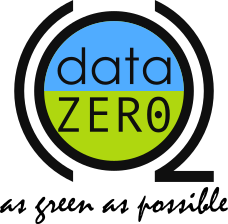WP1: Management
WP2: Characterizing Elements
WP2 will not only prepare all characterizations of every element included in DataZero project, as well as Renewable Energy sources, Electrical Network distribution, DataCenter topology and Computing service split in different computers, but also merge IT/EnR profiling to be used in others optimization WP.
WP2 is thus divided in 3 tasks:
– T2.1 deals with Informatic tasks caracterisation, that means having parameters describing in terms of Power demand and computing capacity/availability on different heterogenous devices (CPU, memory, swith..)
– T2.2 deals with distribution analyse using ePDU/Power converters, provided by EATON, and preparing structured data files to be read/write in the optimization phase and identifying what can/should be done on Power electronics feeding data center to reach a certain Quality of Service.
– T2.3 deals with Energy sources caracterisation, that means establishing a set of parameters showing current, voltage, efficiency evolution of the different EnR sources (Fuel Cell, Battery, SuperCap, Solar Panel..)
The task will be conducted in 2 phases: the first one with fixed a priori structure (deliverable 2.1) using experimental data and measurements from each partners, and in a second step (deliverable 2.2) taking into account parameters dispersion and/or electric distribution topology variation.
WP3 : Monitoring and Reconciliation tools, System model
The main goal of the WP3 is to provide a global view (linked with the optimization performed in WP4) of the electrical and IT systems based on data coming from the WP2 (Sources, IT and Application profiles). Thus, monitoring tools will be developed in order to standardize the way the monitored data are retrieved and stored. Data collected from IT and electrical part, in different formats and on different communication buses, will be gathered in order to serve as input for a common optimization framework.
WP3 is divided in two tasks (with one deliverable for each task):
– T3.1 (Monitoring and reconciling tools) deals with the identification of internal data from IT, and electrical planes but also external data like thermal and environment concerns. Common data models will be normalized and different scales will be defined.
– T3.2 (System level aggregated model) deals with the providing of high level model (energetic), based on the description of individual elements from WP2, of the system including all coupling between IT, electrical and thermal domains. For achieving this aim, Energetic Macroscopic Representation will be used.
WP4 : Optimization, Negotiation
WP4 is focused on the optimization algorithms and techniques to be used for the operation of a datacenter using renewable energy.
Two main problems will be targeted.
First: given an infrastructure and a workload, how to optimize resource operations (IT and electrical) to ensure a service at a given level of satisfaction. Two optimizations linked with a negotiation loop will be done.
The second target problem will study the optimization of the infrastructure (dimensioning and operating both considered) given a workload. In this case, the problem is the infrastructure design where the question is to figure out the best suitable combination of IT and electrical equipment to handle a set of scenarios.
WP4 is thus divided in 4 tasks:
– T4.1 will analyze the different optimization techniques and compare them for solving the problem.
– T4.2 will develop the optimization algorithms
– T4.3 will introduce the negotiation loop between both optimizations to match either side constraints and to determine the required computing service level and power production
– T4.4 will deal with the infrastructure dimensioning optimization
WP5 : Scenarios, Middleware and Software issues
WP5 aims at defining metrics and scenarios against which the project is challenged. The metrics will serve as inputs to WP4 for optimization purpose. They include notions related to operating cost and quality of services. The scenarios will be detailed to be reused in a demonstration and for communication in WP6. A dedicated demonstrator will be developed. It will consist of two optimization modules and one negotiation module within a middleware platform. Thanks a negotiation loop, this platform aims at regulating the power generation by the electrical part using renewable energy to guaranty as far as possible the quality of service delivered by the IT part to end users. Different IT and Electrical configurations will be tested using DCWorms and power emulators (Power Hardware In the Loop – PHIL) that include either software simulated or hardware emulated components.
This WP is divided into 5 tasks:
– T5.1 will select and define metrics and scenarios on which experiments will be based.
– T5.2 will design the middleware architecture on which optimization/decision and negotiation modules are integrated and on which both IT and Electrical parts interact.
– T5.3 will define the IT decision module that implements algorithms defined within WP4. The inputs of this module is the power availability and the workload to run and the output is a set of task allocations that integrate end user constraints. The output of this module will allow both simulator and real testbed to process the target workload.
– T5.4 will develop the Power Hardware in the Loop (PHIL) and the connection part to the middleware of the platform so as to interact with the decision support of the electrical part.
– T5.5 will be in charge of the implementation of scenarios proposed in T5.1.
WP6 : Dissemination, Standardization, Exploitation
WP6 will disseminate the output of the project to a wide audience in order to assess the market relative to the tools and solutions developed as a part of the project. Project results will be disseminated at different levels to reach various kinds of stakeholders including:
● Experts, Scientists, Universities and Research institutes (e.g. through scientific publications and participation in scientific conferences)
● Programmers and software engineers (e.g. through the community created around this website dedicated to Datazero project and participation at industry events)
● Industry executives, managers and end users (e.g. through participation in industry events and standardization bodies related to energy efficiency in data centers)
● Other national or European projects (e.g. through joint workshops or events related to Green Data Centers)
